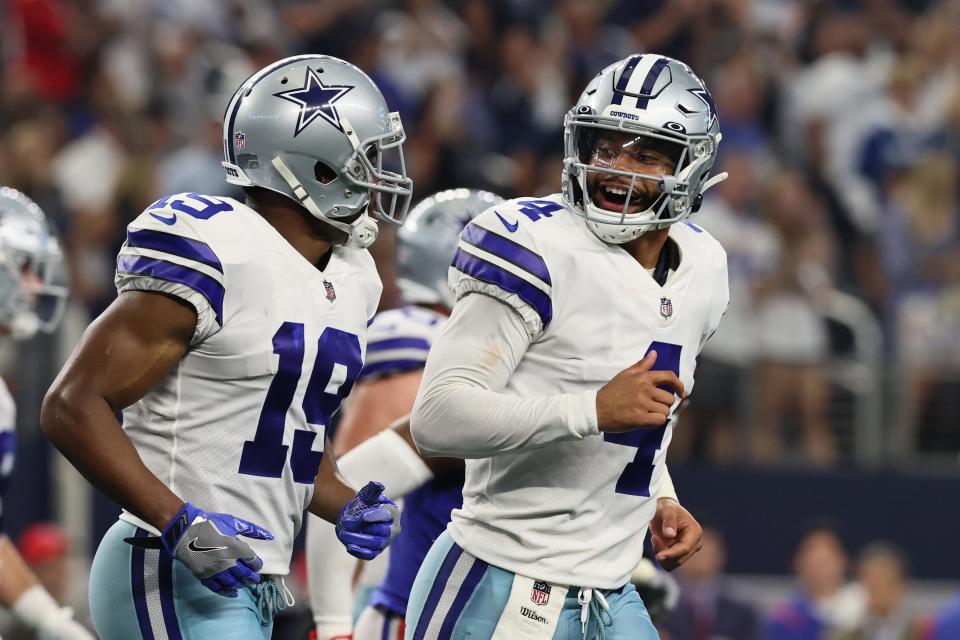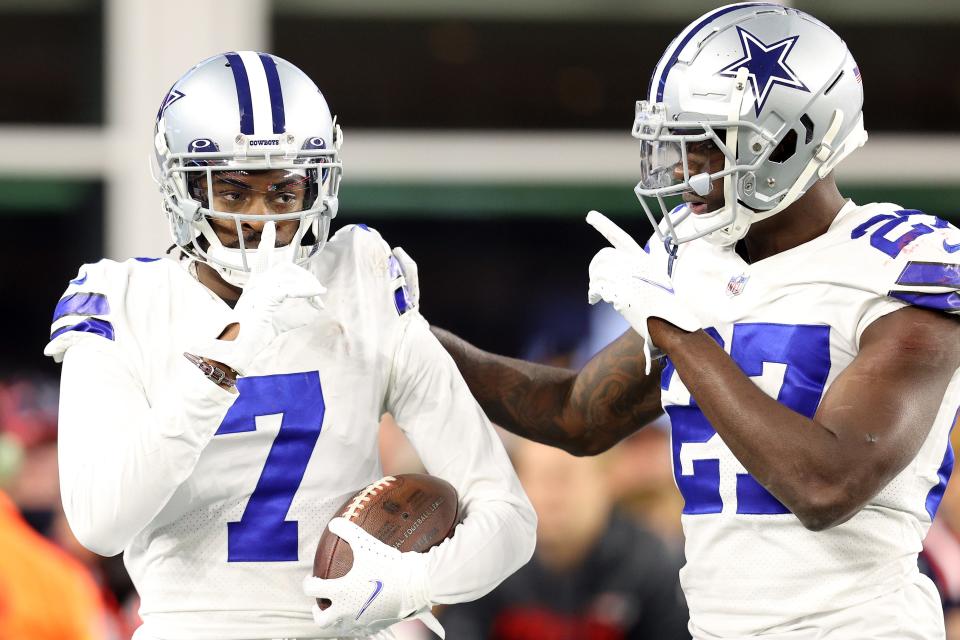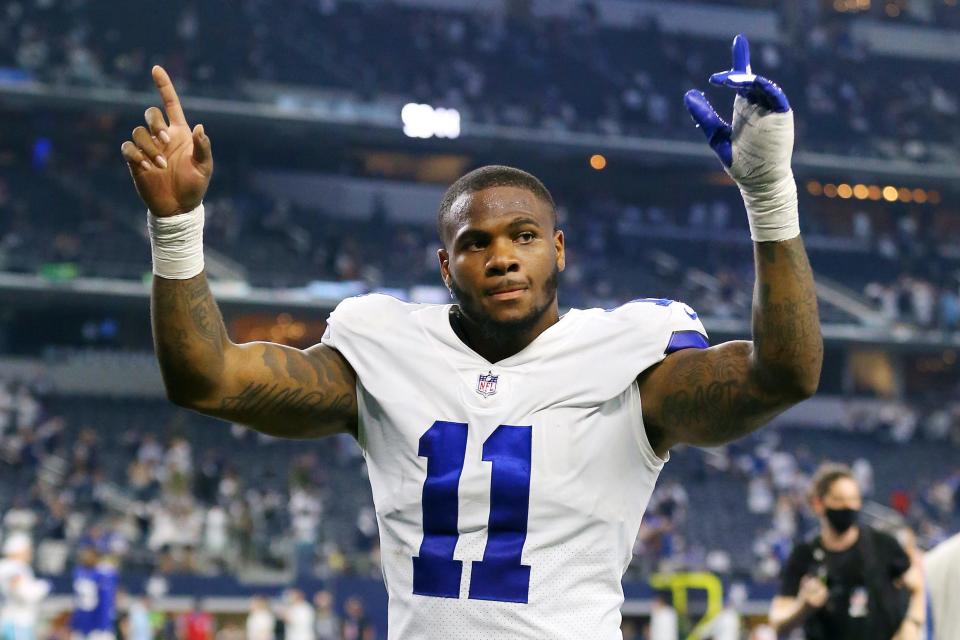Super Bowl contenders? Breaking down 7 keys to the Dallas Cowboys’ early success
- Oops!Something went wrong.Please try again later.
- Oops!Something went wrong.Please try again later.
- Oops!Something went wrong.Please try again later.
- Oops!Something went wrong.Please try again later.
FRISCO, Texas — Cowboys cornerback Anthony Brown and rookie linebacker Micah Parsons sat side by side on the bench at Gillette Stadium. They had just forced the Patriots to punt in overtime, their offense now raring for the game-winning score.
Brown glanced right at Parsons.
“Bro, if we win this, this boosts confidence through the roof,” Brown told Parsons in audio captured by team microphones. “We’ve overcome so much in this game.”
The Cowboys, capped off by a 35-yard touchdown strike from Dak Prescott to wide receiver CeeDee Lamb, overcame decades of futility (25 years, to be exact) against the Patriots in the Week 6 victory ahead of their bye week. But even more important to current players: Dallas improved to 5-1 by demonstrating that rocky stretches in a game will not wreck them as they did in previous seasons. Gone are the close-but-not-quite comebacks the team had in early 2020, when yardage would pile late but ultimately not compensate for offensive turnovers. Gone are the second-half sputters that plagued 2019, the Cowboys never rallying to win any of eight games during which they trailed at halftime that season.
Cowboys QB Dak Prescott to CeeDee Lamb for game-winning TD in overtime.
Cowboys 35, Patriots 29pic.twitter.com/njz8cWi1cB
(via @NFL)— Jori Epstein (@JoriEpstein) October 17, 2021
This 2021 Cowboys team is flashing talent, resilience and stability beyond what its recent predecessors managed. But what is driving the sudden turnaround after a 6-10 unravelling in head coach Mike McCarthy’s first year? And how do the Cowboys suddenly look poised to threaten in the postseason?
USA TODAY Sports broke down seven keys to Dallas’ early success—and how the Cowboys can take each area even further:
NFL POWER RANKINGS: Where do Cowboys stand after 5-1 start?

1. Dak Prescott
The Cowboys committed $40 million a year to Prescott before he had finished rehabilitating from a gruesome fracture and dislocation of his right ankle. Prescott has repeatedly validated that decision. He returned to a 403-yard, three-touchdown opening performance that oozed confidence from his initial 28-yard pass executed off an audibled play. The Cowboys fell to the Buccaneers Week 1, 31-29, but have not lost since.
Prescott’s ability to deploy a variety of game plans at a high level has set the tone for Dallas. He’s one of two quarterbacks this season to pass for 400 yards in multiple games, but he’s also deferred to a powerful run game when defenses like the Chargers and Panthers dictated as much. Prescott’s command of the offense has been hailed by teammates and opposing coaches alike. His ability to decipher coverages and advance to later reads fueled his 445 passing yards and the Cowboys’ 567 offensive yards against the Patriots, the most a Belichick squad has ever ceded.
“Where he’s at right now is really, really special,” offensive coordinator Kellen Moore said. “Playing as high of a level as anyone in the NFL.”
In six games, Prescott has completed 73.1% of passes for 1,813 yards, 16 touchdowns and four interceptions.
To reach the next level: Prescott’s decision making has been superb, but he could play even cleaner, most recently in the red zone. Prescott threw an interception and lost a fumble both in the red zone vs. New England; the Eagles, too, scored off a strip-sack when Dallas was backed up.

2. Takeaways
Quarterbacks may continue to insist they won't avoid Trevon Diggs. Buyer beware. The Cowboys cornerback is only the second NFL player since 1970 with seven interceptions in the first six games of the season. No opponent has avoided his wrath, and twice he has returned an interception for a touchdown. Diggs reminds defensive backs coach Al Harris of Marcus Peters, whom Harris coached in Kansas City when Peters tied for the league lead in interceptions with eight in 2015. Diggs is poised to blow past that mark.
“Passes that other guys may knock down, these guys are getting the ball,” Harris said. “Once all the stars line up where it’s a look, a split, a release—he takes off and goes and gets it.
“I’ve never seen anything like it.”
Cowboys CB Trevon Diggs on his pick-6 vs. Patriots: "They were running it all game. I seen it on film, the double slant to the front side. I just read it and made a play on the ball. He tipped it and it just fell in my hands.
"There was no stopping me."pic.twitter.com/gd5H0mc0hJ— Jori Epstein (@JoriEpstein) October 18, 2021
Dating back to last December, the Cowboys have secured multiple takeaways in 10 consecutive games. Their 14 this season rank second in the league, only the Bills stealing series at a higher clip. In total, seven different defenders have intercepted a pass, forced a fumble or recovered a fumble.
To reach the next level: Takeaways have lifted the Cowboys from last year’s historically bad numbers, the defense improving from the 28th-best scoring unit (29.6 points per game) to 20th (24.3). But they still allow far too many yards (381.2 per game, 23rd) due in large part to explosive plays. The Cowboys have allowed 20+ yards on average of 4.5 passing plays per game. Only the Jaguars and Jets, each at 1-5, have fared worse. Limiting explosive plays was a key emphasis during bye-week self-scout.
“If we can take those explosives out of our game, we go from being a secondary that in my opinion is average to good to the next level,” secondary/pass game coordinator Joe Whitt said. “You can’t be considered great — I don’t care how many interceptions you have — if you’re allowing that many yards.”
3. Run game resurgence
The Cowboys rushing attack struggled last year as Dallas lost four of its five starting offensive linemen to injuries and Ezekiel Elliott aimed to compensate for the loss of Prescott. The result: 111.8 rushing yards per game, 17th in the league. This season, they’ve exploded for 164.3 rushing yards per game (second) and boasted a ferocious two-headed attack with Elliott and third-year back Tony Pollard. Each is on pace for more than 1,000 rushing yards, as the Cowboys aim to give Elliott 60-65% of carries while still employing Pollard as an effective changeup and burst of explosion. It oversimplifies their play styles to suggest Elliott is merely wearing down defenses while Pollard beats them around the edge; each has threatened up the middle and on the perimeter this year, Elliott’s burst better than it has been since his 2016 rookie year. Each has demonstrated patience, lateral quickness and change-of-direction ability. But the difference in their running styles nonetheless challenges defenses.
Cowboys RB Ezekiel Elliott rips off 47-yard carry. Longest rush since rookie year. Against a D that arrived allowing 45 rushing yards per game.pic.twitter.com/QrNH5Ksz4e
— Jori Epstein (@JoriEpstein) October 3, 2021
“All of a sudden (defenders’) angles get confused,” running backs coach Skip Peete said. “They take an angle to come and make the tackle, then all of a sudden the guy’s a little bit quicker and he’s a little further up the field.
“They’re complementing each other.”
To reach the next level: With Elliott averaging 5.1 yards per carry on 17 touches per game and Pollard ripping off 6 a pop on 10.2 opportunities a contest, it’s hard to find much room for improvement in their individual games. But as the Cowboys continue to vary their game plans according to the defense, Elliott and Pollard can enable the team to reach the next level with consistent blocking on more pass-heavy days. Pollard can become a more sure blocker, while Elliott can sharpen his receiving game. Each has already improved in those areas since last season.

4. Offseason moves
The Cowboys invested heavily in defensive acquisition this spring, including eight of their 11 draft selections and a slew of veteran free agents.
Unlike last year, the philosophy worked.
Dallas’ 2020 free-agent class had been so underwhelming that veteran safety Ha Ha Clinton-Dix, defensive tackle Gerald McCoy (injury) and defensive tackle Dontari Poe were all gone before November. In contrast, the Cowboys received meaningful contributions from 2021 veteran acquisitions in linebacker Keanu Neal; defensive tackles Brent Urban and Carlos Watkins; and safeties Damontae Kazee, Jayron Kearse and Malik Hooker. Kearse and Kazee have infused energy into a group that last year faced questions about effort. The Cowboys’ draft class has massively overperformed too. Parsons, the No. 12 overall pick, has wrecked games as both a coverage linebacker and a pass rusher. Add in rookie defensive tackles Osa Odighizuwa and Chauncey Golston unexpectedly suiting up for 60 and 39% of snaps, respectively, and the organization eyes a bright future.
Cowboys rookie Micah Parsons with TFL of Eagles QB Jalen Hurts. Cowboys ball to start Q2, 14-7 lead.pic.twitter.com/jjKqdOSAt6
— Jori Epstein (@JoriEpstein) September 28, 2021
To reach the next level: The Cowboys allowed 14 points in the Patriots’ first seven plays. That, and a one-play, 75-yard touchdown late in the game, indicated how damaging the defensive lapses have been. Coaches lauded the team’s resilience, but the room for growth is evident. Defensive coordinator Dan Quinn describes the defense as an “up-and-coming” group. Time on task for young players is part of the battle.
“Some days it just doesn’t come your way by the nature of the call or the scheme they’re using,” Quinn said. “But if you stay consistent and you stay relentless, you have opportunities when they come.”
5. A long-time gamble paying off
Randy Gregory’s decisive sacks of Mac Jones in New England sent a message. “He walks into the game feeling like he can take it over,” defensive line coach Aden Durde said. “And he does.”
The Cowboys have supported the talented pass rusher on and off the field since selecting him in the second round of the 2015 NFL draft. Repeated violations of the league’s substance-abuse policy triggered a total of 46 games missed due to suspension. But Gregory has grown since he was reinstated nearly 14 months ago from his most recent suspension. His length, agility, explosiveness and intelligence have posed a weekly threat to opponents. That impact has manifested in four sacks, a forced fumble, a fumble recovery and regular holding calls on offensive linemen. At times, like in the second quarter of the Cowboys’ overtime win over the Patriots, such a holding call eliminated a touchdown. Gregory admitted he was playing mad, and the juice carried. His sacks took just 1.9 and 2.3 seconds, respectively, per advanced analytics site Pro Football Focus.
“I think our the last two years, it really cemented in my head that I can play at a high level,” Gregory said. “Now it’s just about staying out there, staying available and being able to stay consistent out there to make plays.”
Randy Gregory: strip sack.
Cowboys ball.
(@nfl)pic.twitter.com/vuxgVLxIeb— Jori Epstein (@JoriEpstein) October 17, 2021
To reach the next level: Gregory himself acknowledges every day is a mental challenge and he sees ample room to grow. But he’s avoided off-field impediments for the better part of two years now. Once on the field, Gregory’s consistent availability has allowed him to develop a command of the pass rush he hadn’t yet reached. He has honed his moves and hand usage to make his natural athletic gifts more explosive. And he’s wrecked drives despite the Cowboys’ previous best defender, left edge DeMarcus Lawrence, suffering a broken foot that has sidelined him since Week 1. If Lawrence can return from foot surgery in the coming weeks, defenses will have to divert some of their attention away from Gregory.
6. Coaching
Some of the coaching improvement simply boils down to continued growth. In his third year as Cowboys offensive coordinator, Kellen Moore has developed the most creative play calls of his career, his most concise delivery of them in real time and his most effective game-planning relationship with Prescott. Moore implores his players to “aggressively take what the defense gives us,” and the Cowboys have. No team has scored more points per game (34.2) or racked up more yards (460.8). Dallas ranks top-five in passing yards, rushing yards, first downs per game and third-down conversion percentage. Ball distribution is diverse, new wrinkles enter the game plan each week, and Moore is innovating even from quarter to quarter.
Cowboys OC Kellen Moore, QB Dak Prescott conferred at halftime yesterday to change 2 looks based on Panthers D in 1st half. Result: TDs to Amari Cooper, Cedrick Wilson.
“Adjustment football is part of the process,” Kellen tells us. Not reinventing game at half; re-establishing. pic.twitter.com/e7CqckhFh4— Jori Epstein (@JoriEpstein) October 4, 2021
Defensively, Quinn has reestablished a culture emphasizing high motor, communication and trust. Players appear far more confident with their assignments than Dallas’ 2020 defenders were, enabling them to better fill their own role and support others. Quinn is careful to confirm players understand any scheme that will appear in the game plan. And when an assignment or package doesn’t work? Quinn is quick to tell players, and reporters, that he needed to install it differently. Quinn and his staff deserve portions of credit for the rapid development of first- and second-year players like Parsons and Diggs.
To reach the next level: Moore wants to further double down on his red-zone calls, including his quarterback sneak tactics after seeming touchdowns by Prescott have flopped in two games. Quinn wants to continue adding concepts into his system that he chose not to integrate at the beginning of the season and best position his players to limit explosive plays and yards after the catch. More globally, McCarthy can continue to hone his clock management strategy.
7. The Great Wall of Dallas
The Cowboys offensive line was their best asset in 2016, when Dallas raced to 13-3 in Prescott and Elliott’s rookie season. It’s again dominant, but the performance is perhaps less stark now that the Cowboys have such deep stables of weapons.
When Pro Football Focus ranked all 32 offensive lines after five games, the Cowboys received the best team mark. Four-time All-Pro right guard Zack Martin has set the tone for rushing lanes while seven-time Pro Bowl left tackle Tyron Smith has returned from neck surgery to manhandle rushers.
How has this manifested on the field? In pass protection, the Cowboys rank top-5 allowing 1.5 sacks per game. In the run game, Elliott and Pollard insist the top-two rushing attack is a product of the holes their linemen are creating. Cowboys players cite the defensive linemen whom they see panting as the game elapses and they wear down further.
Cowboys OC Kellen Moore on Zack Martin: "I don't know what Madden's 99s are but Zack should probably be sitting there. The guy's playing as good as anyone in the National Football League.
"I know (right guard)'s not the sexiest, coolest position in the world. But he's amazing."— Jori Epstein (@JoriEpstein) October 4, 2021
“One thing about being an offensive lineman, you’re in a physical confrontation every single snap,” offensive line coach Joe Philbin said.
The Cowboys’ liberally-labeled dilemma at right tackle points to how far they’ve come from a year ago. As veteran starter La’el Collins returns from a five-game suspension, the Cowboys now have two right tackles capable of playing at a high level. Second-year undrafted free agent Terence Steele cobbled together a rookie year of hastily needed starts with an offseason focused on core strength, hand usage and pass sets to arrive at the Cowboys’ Week 2 Chargers game with sufficient development to ward off Joey Bosa.
To reach the next level: Center Tyler Biadasz, who has started six games since he was drafted in the 2020 fourth round, has room to grow. Botched snaps are far too common for this Cowboys team, and the interior pass protection—including the gap between Biadasz and left guard Connor Williams—has slipped against stouter defensive tackles. Another area to improve: reducing penalties. The Cowboys yielded a whopping 115 yards on 12 penalties against the Patriots; eight were called against offensive linemen, with every single starting lineman penalized at least once. McCarthy, Philbin and players raised eyebrows at some of the officiating decisions. But Philbin said he must coach better to ensure that doesn’t happen again.
“Sometimes you just got to stay above the letter of the law,” Philbin said. “Whether I think it was an egregious penalty or not…doesn’t matter. What matters is we’re maybe in first-and-20 and we got to get ourselves out of it.”
Follow USA TODAY Sports’ Jori Epstein on Twitter @JoriEpstein.
This article originally appeared on USA TODAY: Dallas Cowboys: 7 keys to team's rise as Super Bowl contenders

